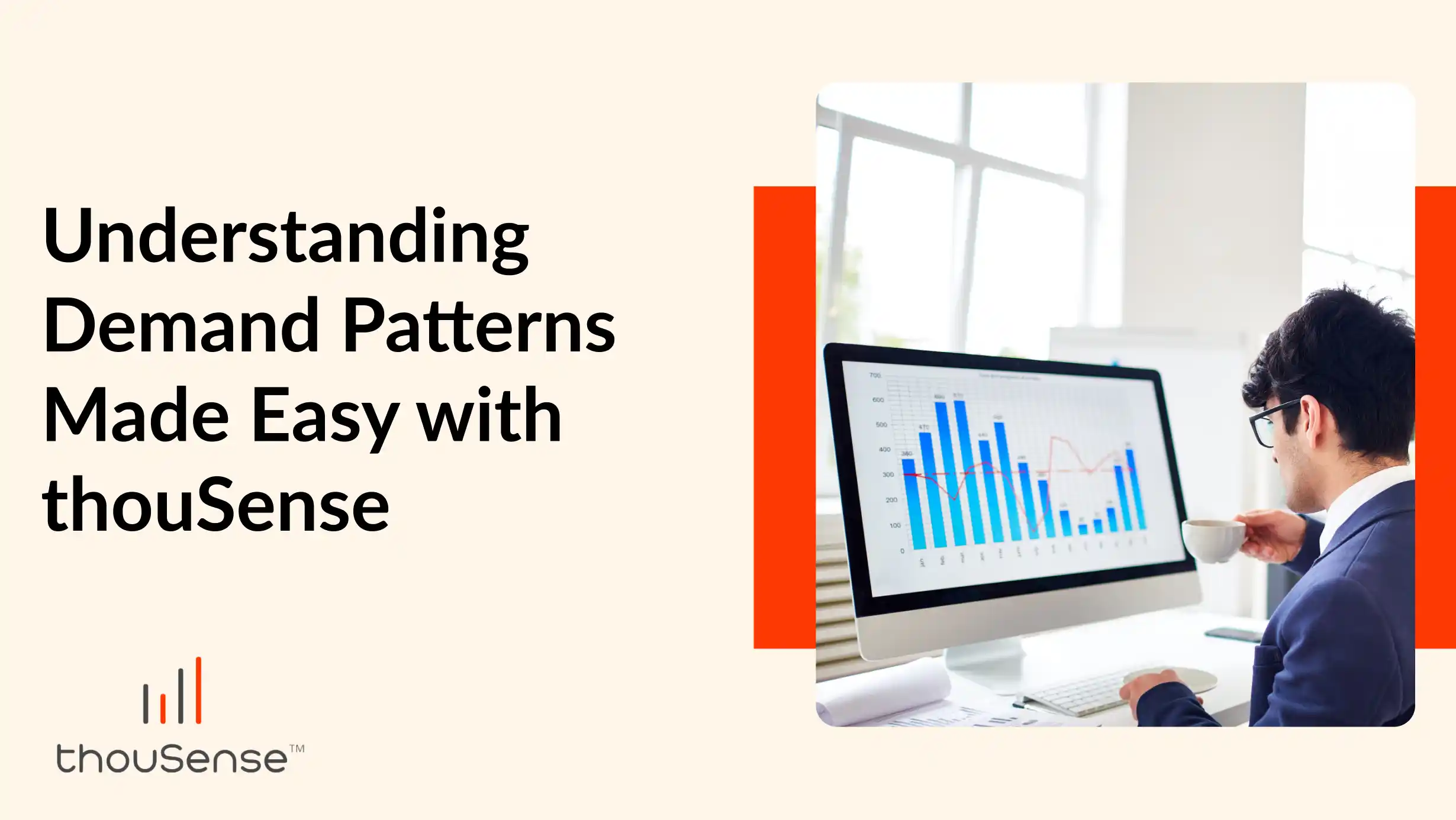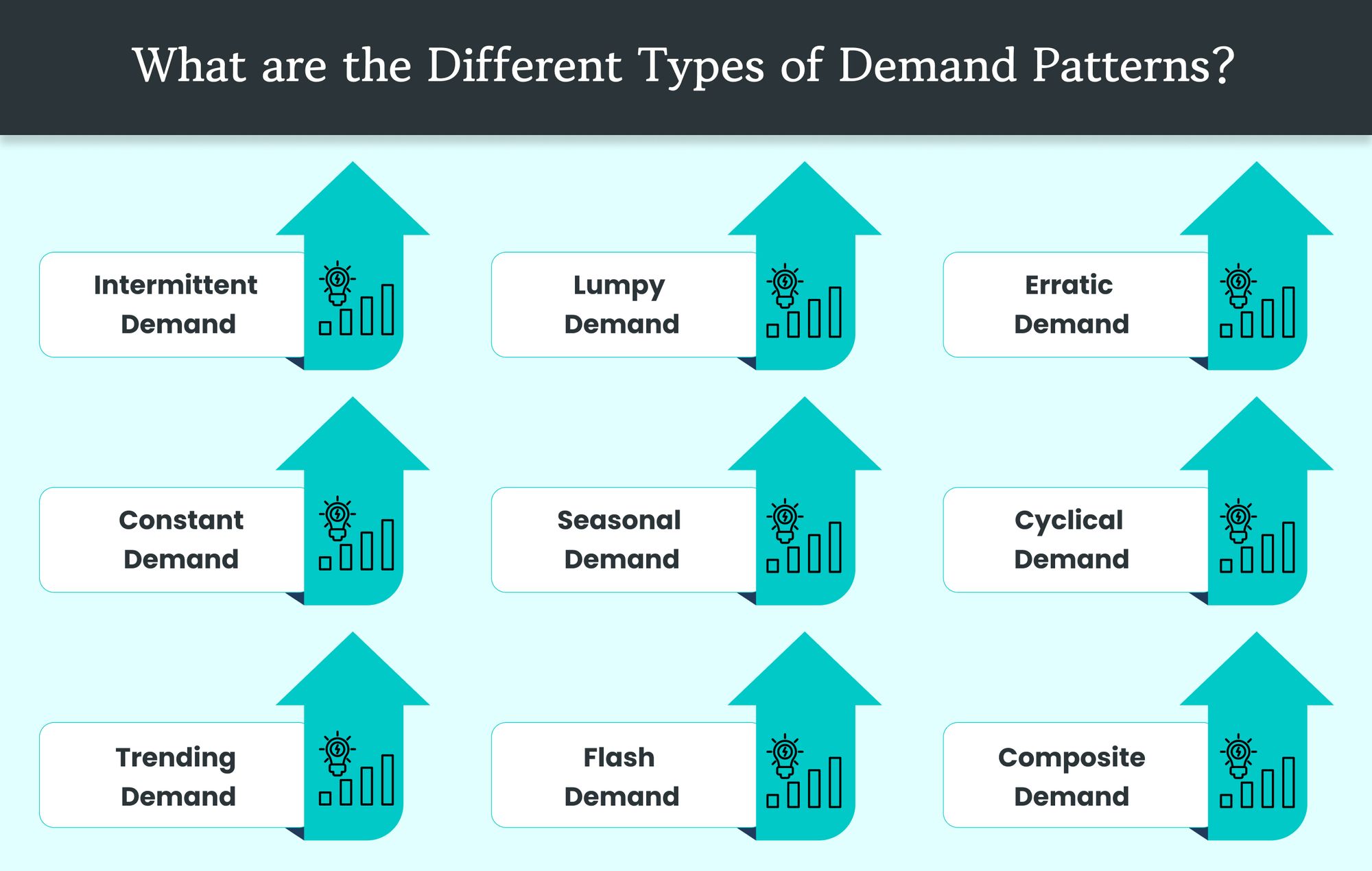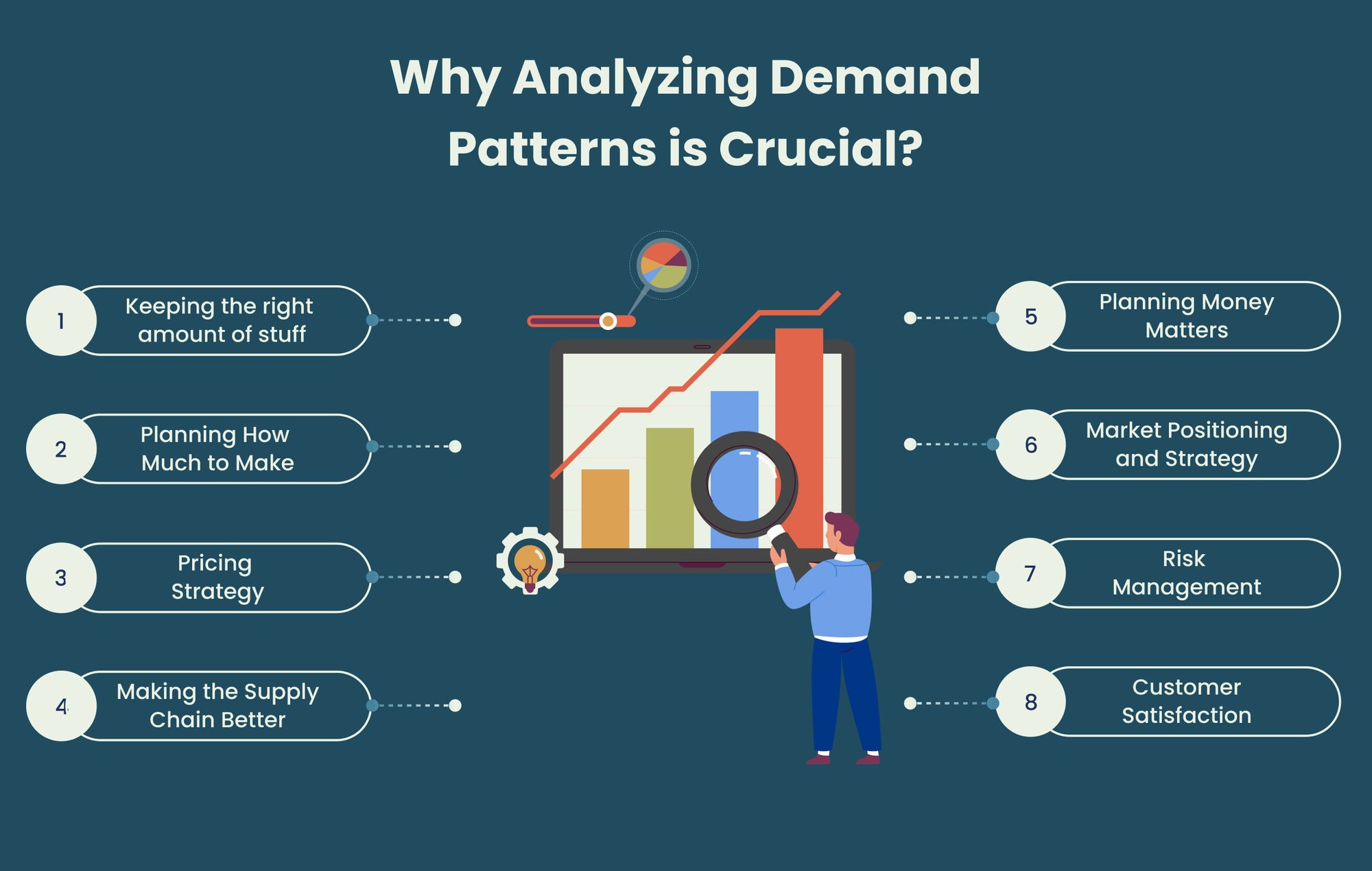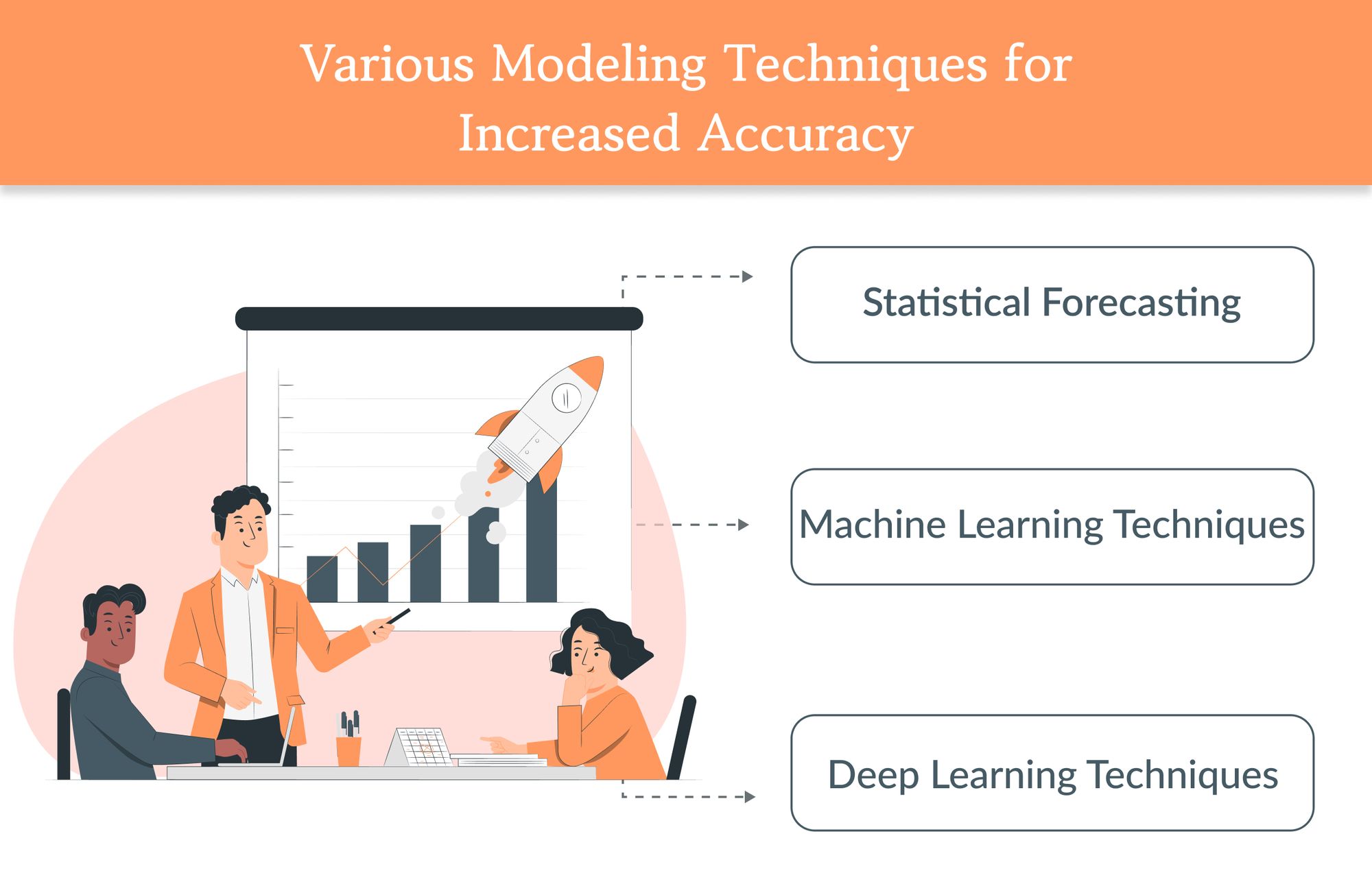Understanding Demand Patterns Made Easy with thouSense

Introduction
The customer’s demand patterns are dynamic and it is quite important for the business to stay ahead of it. But, finding this out can be hard because there's so much information to look at. This is where thouSense comes in to help. It offers a new way to make this tough job easier for lots of companies. This article will talk about how thouSense can help big and small businesses figure out what their customers want.
What are the Different Types of Demand Patterns?
Demand patterns can have a big impact on production scheduling, inventory management, and overall business strategy since they are a long-term reflection of customer purchasing behavior. An outline of the main categories of demand patterns is provided below:

1. Intermittent Demand
Demand fluctuations are the hallmark of intermittent demand, which is frequently observed in the market for specialist equipment and spare components. It is challenging to forecast when and how much demand will arise again due to its irregular nature.
2. Lumpy Demand
Similar to intermittent demand, lumpy demand also involves a great deal of fluctuation in the amount of demand when it does occur. It is typical in industries where irregular bulk orders are placed, making it difficult to maintain the ideal level of inventory.
3. Erratic Demand
The demand which is characterized by random shifts devoid of any clear pattern or trend. This is frequently influenced by variables like customer behavior changes, market developments, and external economic situations.
4. Constant Demand:
This pattern is defined by minimal swings in demand throughout time. Essential and often used products, such as household supplies or basic food items, are frequently in regulat demand. Predictable sales trends help businesses that deal with continuous demand by making inventory and production planning easier.
5. Seasonal Demand:
Seasonal demand is the term used to describe notable variations in demand patterns at particular periods of the year, frequently brought on by events, holidays, or seasons. For instance, retail establishments may experience a spike in demand for specific goods around the holidays. Businesses must comprehend seasonal demand trends to prevent overstocking during off-peak hours and to effectively prepare for times of high demand.
6. Cyclical Demand:
Cyclical demand patterns typically span longer time spans, frequently many years, and are impacted by macroeconomic forces. These demand patterns are commonly observed in sectors such as real estate, automobiles, and luxury products, where demand fluctuates in tandem with the state of the economy. Businesses must stay up to date on economic developments in order to anticipate cyclical demand and modify their strategy accordingly.
7. Trending Demand:
This refers to a sustained rise or fall in the market for a specific good or service, frequently as a result of alterations in customer tastes, developments in technology, or changes in society. For example, a trending demand pattern is shown in the growing preference for electric automobiles over conventional gasoline-powered cars. Companies need to keep an eye on market trends in order to take advantage of rising demand and phase out falling products.
8. Flash Demand:
This word describes extremely brief surges in patterns of demand, usually brought on by certain occasions, sales, or viral fads. While these increases are often transient, they can be quite strong. Companies who can swiftly take advantage of flash demand patterns of demand—for example, by utilizing social media trends or flash sales—may see a large increase in revenue, but they may also have difficulties with supply chain management and logistics.
9. Composite Demand:
When a good or service is required for several reasons, it creates a patterns of demand that is impacted by a number of variables. For instance, corn might be needed for the manufacturing of biofuel, animal feed, and culinary goods. To properly prepare, businesses dealing with composite demand need to comprehend the many markets and factors impacting demand.
Why Analyzing Demand Patterns is Crucial?
Looking at demand patterns is super important for businesses. It helps with a lot of things. Such as figuring out how much stuff to keep on hand and planning how much to make. By understanding what customers want and when, businesses can be ready instead of just reacting to what's happening.
Here's why checking demand patterns is a big deal:

1. Keeping the right amount of stuff:
By guessing the pattern of demand right, businesses can have just the perfect amount of items they need. This way, they don't run out and make customers unhappy. Or do not have too much stuff that nobody buys, which can cost a lot of money. Good management of items helps keep customers happy and saves money.
2. Planning How Much to Make:
Knowing when people want more or less of something helps businesses make just the right amount. If people have a high demand pattern of something at certain times like ice cream in summer or jackets in winter. Companies can get ready by making more of those things just at the right time. This way, they don’t spend too much making things they don't need or end up not having enough of what people want.
3. Pricing Strategy:
How much something costs can change depending on patterns of demand. For instance, when lots of people want something, businesses might make it cost more so they can earn more money. But if not many people want it, they might make it cheaper so more people will buy it. By understanding when more or less people want something, businesses can change their prices to sell more and make more money, while also staying ahead of other businesses.
4. Making the Supply Chain Better:
When businesses really understand comprehensive awareness of demand patterns, they can make their supply chainwork better. This means they might change when they buy materials, make delivering products faster and smoother. And work better with the people who supply them and help them send out products. This way, they make sure that the products are ready and available for people to buy exactly when and where they need them.
5. Planning Money Matters:
Guessing how much of their products will be wanted in the future is super important for businesses when they think about their money plans. By making good guesses, businesses can make smart choices about spending money, making their business bigger, and how to use their money best. This helps the business grow strong and stable, keeping their money health in good shape.
6. Market Positioning and Strategy:
Businesses can better position their goods and services by understanding market dynamics and consumer preferences through the analysis of demand patterns. This knowledge can help with the creation of new goods, the targeting of untapped markets, or the repurposing of already-existing products to better serve clientele.
7. Risk Management:
You can drastically lower business risks by anticipating and recognizing demand pattern variations. Businesses may increase their resilience to market variations by predicting shifts in demand and putting policies in place to profit on upturns and lessen the impact of downturns.
8. Customer Satisfaction:
In the end, by making sure that goods and services are available when and where they are needed, firms can better serve their clients by comprehending demand patterns. This improves customer happiness and encourages repeat business and loyalty, which can increase sales through positive word-of-mouth.
How thouSense is Simplifying Demand Patterns?
The capacity to effectively estimate demand patterns has become essential to successful corporate operations in today's dynamic and complex market environment. Introducing thouSense, a state-of-the-art solution that uses a variety of modeling techniques along with its unique Intelligent Segmentation Report to completely change the way businesses approach demand forecasting.
● Summary: With its smooth integration, thouSense gives you a comprehensive picture of patterns of demand throughout your company.
● Features: With features ranging from predictive modeling to real-time data analysis, thouSense provides a wealth of information on customer behavior.
● Advantages: Because of thouSense's precise patterns of demand, businesses using it can anticipate considerable improvements in decision-making, inventory management, and customer happiness.
The thouSense Method: Intelligent Segmentation Report
The Intelligent Segmentation Report is the foundation of thouSense's cutting-edge forecasting technique. This method allows for a tailored approach to forecasting by carefully classifying demand into distinct patterns. Demand forecasts are much more accurate thanks to thouSense's ability to identify the distinctive features of each demand pattern and apply the best forecasting model.
Various Modeling Techniques for Increased Accuracy
thouSense doesn't depend on a universally applicable answer. Understanding that demand patterns are not all the same, it uses a variety of modeling techniques to address each unique problem:

Statistical Forecasting: ThouSense employs statistical techniques to precisely predict future demand for patterns using historical data that exhibit a discernible trend or seasonality.
Machine Learning Techniques: thouSense makes use of machine learning techniques when demand patterns show greater intricacy. By spotting minute patterns and connections in the data that more conventional approaches would overlook, these algorithms enable more dynamic demand adaptation.
Deep Learning Techniques: ThouSense applies deep learning techniques to the most stochastic demand patterns. These models are extremely useful for forecasting because they can process large amounts of data and learn from it.
How to Implement and Transform Demand Analysis with thouSense?
Putting thouSense into a company's work is easy for forecasting demand patterns. First, you add data from different places into it. Next, you make changes to the platform so it fits what the company needs. Companies should also use the help and learning stuff thouSense offers to get the most out of it.
In short, thouSense is a big deal for understanding what products people want and when. It makes hard data easy to get and use, so companies can make their plans better and really understand what their customers want. By using thouSense, companies can handle today's tricky market well, making sure they lead the way instead of just following along.
FAQs
1. How does thouSense handle data privacy?
thouSense prioritizes data security and privacy, employing industry-standard practices to ensure your information remains protected.
2. Can thouSense integrate with my existing systems?
Yes, thouSense is designed to seamlessly integrate with a wide range of systems, ensuring a smooth implementation process.
3. Is thouSense suitable for small businesses?
Absolutely. thouSense is scalable and can provide valuable insights to businesses of any size, including small enterprises.
4. How does thouSense predict future demand patterns?
thouSense uses a combination of historical data analysis and machine learning algorithms to forecast future demand with high accuracy.
5. What support is available for thouSense users?
thouSense offers comprehensive support, including training sessions, documentation, and a dedicated customer service team to assist with any queries.